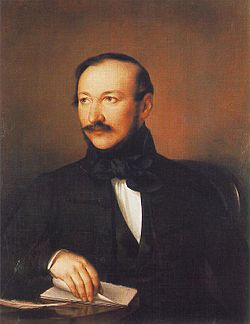Mihály Vörösmarty
This article needs additional citations for verification. (July 2020) |
Mihály Vörösmarty | |
|---|---|
Habsburg Monarchy | |
| Died | 19 November 1855 (aged 54) Pest, Austrian Empire |
| Spouse | Laura Csajághy |
| Children | Béla Ilona Erzsébet |
Mihály Vörösmarty (archaically English: Michael Vorosmarthy
Biography

He was born at
The activities of the Diet of 1825 enkindled his patriotism and gave a new direction to his poetry. He had already begun a drama, Salomon. He flung himself into public life and fell in love with Etelka Perczel, who was from a higher social class. Many of his lyrics concern this unrequited love. Meanwhile, his patriotism found expression in the heroic epic Zalán futása (The Flight of Zalán, 1824), which, while dealing with the Hungarian past, also dealt with contemporary political concerns.[3] This new epic marked a transition from the classical to the romantic school. Vörösmarty was hailed by Károly Kisfaludy and the Hungarian romanticists as one of their own. He had forsaken the law for literature, and his financial situation deteriorated. Between 1823-31, he composed four dramas and eight smaller epics, partly historical, partly fanciful. Of these epics he always regarded Cserhalom (1825) as the best, but later criticism preferred A két szomszédvár (Two Neighbouring Castles, 1831).[2]

When the Hungarian Academy was established on 17 November 1830 he was elected a member of the philological section, and ultimately succeeded Károly Kisfaludy as director with an annual pension of 500 florins. He was one of the founders of the Kisfaludy Society, and in 1837 started two periodicals: the Athenaeum and the Figyelmező. The first was the chief bellettristic periodical, and the second was a critical periodical.[2]
From 1830-43, he devoted himself mainly to drama, including Csongor és Tünde (Csongor and Tünde, 1830), a five-act play inspired by Albert Gergei's Prince Árgirus and by Shakespeare's A Midsummer Night's Dream; and Vérnász (Blood Wedding, 1833), which won the Academy's 200-gulden prize.[2] Csongor és Tünde was described by György Lukács in 1911 as the best Hungarian play of the nineteenth century.[citation needed] He also published several volumes of poetry. His song "Szózat" ("Appeal", 1836) was to become a second national anthem, and he wrote "Az elhagyott anya" ("The Abandoned Mother", 1837) and "Az uri hölgyhöz" ("To the Noble Lady", 1841). His marriage in 1843 to Laura Csajághy inspired him to compose a new cycle of love poems. They had five children, including Béla and Ilona. In 1848, in conjunction with Arany and Petőfi, he contributed to a translation of William Shakespeare's works.[2]

With the support of
Honors
- A monument by Ede Kallós and Eduard Telcs, constructed in the 1900s, stands in Budapest in the square which bears his name.[4]
- Mihály Vörösmarty stamp was issued by Hungary on 5 May 1937 showing his portrait.[5]
- Another stamp was issued by Hungary on 28 July 1955 in the Poets series.[5]
References
- ^ Author, and sold: Poetry of the Magyars: Preceded by a Sketch of the Language and Literature of Hungary and Transylvania -PAGE: 173
- ^ a b c d e f One or more of the preceding sentences incorporates text from a publication now in the public domain: Bain, Robert Nisbet (1911). "Vörösmarty, Mihály". In Chisholm, Hugh (ed.). Encyclopædia Britannica. Vol. 28 (11th ed.). Cambridge University Press. p. 213.
- ^ Bak, János M. (2015). "From the Anonymous Gesta to the Flight of Zalán by Vörösmarty". In Bak, János M.; Geary, Patrick J.; Klaniczay, Gábor (eds.). Manufacturing a Past for the Present: Forgery and Authenticity in Medievalist Texts and Objects in Nineteenth Century Europe. Brill. p. 103.
- ^ "Képzőművészet Magyarországon - Fine Arts in Hungary". Fine Arts in Hungary. Retrieved 9 August 2020.
- ^ ISBN 978-0-85259-741-5.
External links
- Works by or about Mihály Vörösmarty at Internet Archive
- Works by Mihály Vörösmarty at LibriVox (public domain audiobooks)

- Mihály Vörösmarty at Hunlit.hu
